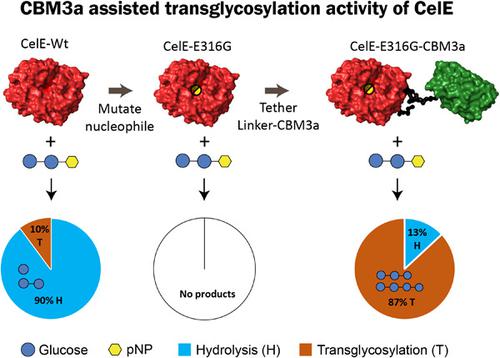当前位置:
X-MOL 学术
›
Biotechnol. Bioeng.
›
论文详情
Our official English website, www.x-mol.net, welcomes your
feedback! (Note: you will need to create a separate account there.)
Carbohydrate-binding domains facilitate efficient oligosaccharides synthesis by enhancing mutant catalytic domain transglycosylation activity.
Biotechnology and Bioengineering ( IF 3.5 ) Pub Date : 2020-06-23 , DOI: 10.1002/bit.27473 Chandra Kanth Bandi 1 , Antonio Goncalves 1 , Sai Venkatesh Pingali 2 , Shishir P S Chundawat 1
Biotechnology and Bioengineering ( IF 3.5 ) Pub Date : 2020-06-23 , DOI: 10.1002/bit.27473 Chandra Kanth Bandi 1 , Antonio Goncalves 1 , Sai Venkatesh Pingali 2 , Shishir P S Chundawat 1
Affiliation

|
Chemoenzymatic approaches using carbohydrate‐active enzymes (CAZymes) offer a promising avenue for the synthesis of glycans like oligosaccharides. Here, we report a novel chemoenzymatic route for cellodextrins synthesis employed by chimeric CAZymes, akin to native glycosyltransferases, involving the unprecedented participation of a “non‐catalytic” lectin‐like domain or carbohydrate‐binding modules (CBMs) in the catalytic step for glycosidic bond synthesis using β‐cellobiosyl donor sugars as activated substrates. CBMs are often thought to play a passive substrate targeting role in enzymatic glycosylation reactions mostly via overcoming substrate diffusion limitations for tethered catalytic domains (CDs) but are not known to participate directly in any nucleophilic substitution mechanisms that impact the actual glycosyl transfer step. This study provides evidence for the direct participation of CBMs in the catalytic reaction step for β‐glucan glycosidic bonds synthesis enhancing activity for CBM‐based CAZyme chimeras by >140‐fold over CDs alone. Dynamic intradomain interactions that facilitate this poorly understood reaction mechanism were further revealed by small‐angle X‐ray scattering structural analysis along with detailed mutagenesis studies to shed light on our current limited understanding of similar transglycosylation‐type reaction mechanisms. In summary, our study provides a novel strategy for engineering similar CBM‐based CAZyme chimeras for the synthesis of bespoke oligosaccharides using simple activated sugar monomers.
中文翻译:

碳水化合物结合域通过增强突变催化域转糖基化活性来促进有效的寡糖合成。
使用碳水化合物活性酶 (CAZymes) 的化学酶法为合成寡糖等聚糖提供了有希望的途径。在这里,我们报告了嵌合 CAZymes 采用的纤维糊精合成的新化学酶促途径,类似于天然糖基转移酶,涉及“非催化”凝集素样结构域或碳水化合物结合模块 (CBM) 在糖苷催化步骤中的前所未有的参与。使用β-纤维二糖供体糖作为活化底物的键合成。CBM 通常被认为在酶促糖基化反应中发挥被动底物靶向作用,主要是通过克服束缚催化结构域 (CD) 的底物扩散限制,但不知道直接参与影响实际糖基转移步骤的任何亲核取代机制。该研究为 CBM 直接参与 β-葡聚糖糖苷键合成的催化反应步骤提供了证据,使基于 CBM 的 CAZyme 嵌合体的活性比单独的 CD 提高了 140 倍以上。小角度 X 射线散射结构分析以及详细的诱变研究进一步揭示了促进这种知之甚少的反应机制的动态域内相互作用,以阐明我们目前对类似转糖基化类型反应机制的有限理解。总之,我们的研究提供了一种新的策略,用于设计类似的基于 CBM 的 CAZyme 嵌合体,用于使用简单的活化糖单体合成定制的寡糖。
更新日期:2020-06-23
中文翻译:

碳水化合物结合域通过增强突变催化域转糖基化活性来促进有效的寡糖合成。
使用碳水化合物活性酶 (CAZymes) 的化学酶法为合成寡糖等聚糖提供了有希望的途径。在这里,我们报告了嵌合 CAZymes 采用的纤维糊精合成的新化学酶促途径,类似于天然糖基转移酶,涉及“非催化”凝集素样结构域或碳水化合物结合模块 (CBM) 在糖苷催化步骤中的前所未有的参与。使用β-纤维二糖供体糖作为活化底物的键合成。CBM 通常被认为在酶促糖基化反应中发挥被动底物靶向作用,主要是通过克服束缚催化结构域 (CD) 的底物扩散限制,但不知道直接参与影响实际糖基转移步骤的任何亲核取代机制。该研究为 CBM 直接参与 β-葡聚糖糖苷键合成的催化反应步骤提供了证据,使基于 CBM 的 CAZyme 嵌合体的活性比单独的 CD 提高了 140 倍以上。小角度 X 射线散射结构分析以及详细的诱变研究进一步揭示了促进这种知之甚少的反应机制的动态域内相互作用,以阐明我们目前对类似转糖基化类型反应机制的有限理解。总之,我们的研究提供了一种新的策略,用于设计类似的基于 CBM 的 CAZyme 嵌合体,用于使用简单的活化糖单体合成定制的寡糖。











































 京公网安备 11010802027423号
京公网安备 11010802027423号